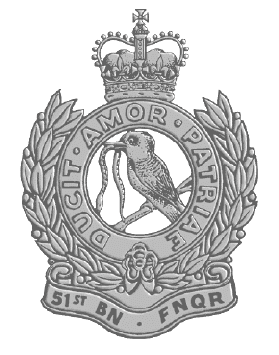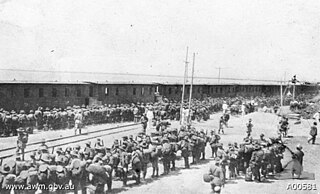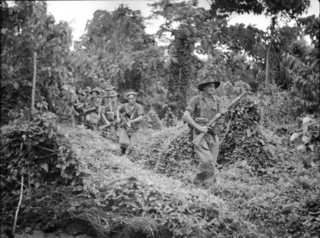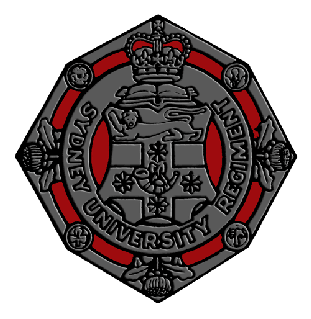
The 51st Battalion, Far North Queensland Regiment is an Australian Army Regional Force Surveillance Unit headquartered at Porton Barracks in Cairns. The battalion's primary role is to conduct reconnaissance and surveillance tasks in support of border security operations. Its area of operations includes the Torres Strait and the Cape York littoral environment. Additional tasks for 51FNQR include the collection and collation of military geographic information as well as community engagement and disaster relief operations.

The Royal Queensland Regiment (RQR) is a reserve light infantry regiment of the Australian Army based in Queensland. Part of the Royal Australian Infantry Corps, the regiment was established in 1960 following a reorganisation of Australia's part-time infantry regiments that saw the creation of six state-based regiments through the amalgamation of the previously existing regionally designated infantry battalions. Initially only two battalions were raised, but since then the size of the regiment has fluctuated depending upon the Army's requirements. There are currently three battalions within the regiment based at various locations throughout Queensland, all of which are assigned to the 11th Brigade.

The Royal New South Wales Regiment (RNSWR) is a reserve infantry regiment of the Australian Army based in the state of New South Wales.

The 1st Battalion was an infantry battalion of the Australian Army. Although its numerical name was designated during the First World War, the 1st Battalion can trace its lineage back to 1854, when a unit of the Volunteer Rifles was raised in Sydney, New South Wales. This unit has since been redesignated a number of times, but through its links with the units of the colonial NSW defence force, the battalion's history includes services in Sudan and South Africa. During the First World War, the 1st Battalion was raised for overseas service in 1914 as part of the First Australian Imperial Force. Attached to the 1st Brigade, the battalion served in Egypt initially before taking part in the fighting in Gallipoli against the Turks. Later the battalion was sent to the Western Front where it fought in the trenches in France and Belgium as part of the Australian Corps. Following the end of the war the battalion was disbanded in 1919.

The 2nd Battalion was an infantry battalion of the Australian Army. It was initially raised for service during the First World War as part the Australian Imperial Force and saw action at Gallipoli before being sent to the Western Front in mid-1916, where it spent the next two-and-a-half years taking part in the fighting in the trenches of France and Belgium. Following the conclusion of hostilities, the battalion was disbanded in early 1919 as part of the demobilisation process.

The 3rd Battalion was an infantry battalion of the Australian Army. Originally raised as part of the First Australian Imperial Force for service during World War I, the battalion formed part of the 1st Brigade, attached to the 1st Division. It was formed shortly after the war broke out and was among the first Australian units to be sent overseas, arriving in Egypt in December 1914. In April 1915 the battalion participated in the Landing at Anzac Cove, coming ashore in the second and third waves. In December 1915 the 3rd Battalion was evacuated from the Gallipoli peninsula and withdrawn to Egypt again, where it took part in the defence of the Suez Canal before being sent to France to fight on the Western Front in March 1916. For the next two and a half years the unit would serve in the trenches in France and Belgium and would take part in many of the major battles fought during that time. In May 1919, following the end of the war, the battalion was disbanded and its personnel repatriated back to Australia.

The 4th Battalion was an infantry battalion of the Australian Army. Originally raised as part of the First Australian Imperial Force during the First World War, the battalion formed part of the 1st Brigade, attached to the 1st Division. During the war the battalion fought at Gallipoli and in the trenches on the Western Front, before being disbanded in 1919. In 1921, the battalion was re-raised as a militia unit and designated as the "4th Battalion ", adopting the designation of the Australian Rifles militia unit from which many of the battalion's recruits had come during the war. In 1930, the battalion was amalgamated with the 3rd Battalion and they remained linked until 1936, when they were delinked.
The 5th Battalion was an infantry battalion of the Australian Army. Raised in Victoria as part of the First Australian Imperial Force for service during World War I, the battalion formed part of the 2nd Brigade, attached to the 1st Division. It participated in the landing at Anzac Cove on 25 April 1915, coming ashore in the second wave, before taking part in the fighting at Krithia and then at Lone Pine. In December 1915, the battalion was withdrawn from the peninsula and returned to Egypt where it was involved in defending the Suez Canal until being transferred to the Western Front in France in early 1916. After that, over the course of the next two and a half years the 5th Battalion was rotated in and out of the front line and took part in a number of significant battles including at Pozieres, Ypres, Amiens and the Hindenburg Line. Following the end of the war, the battalion was disbanded and its personnel returned to Australia. The battalion was re-raised during the inter-war years as a part-time unit and was later mobilised during World War II, but did not serve overseas. During the post war period, the battalion has existed at various times before being subsumed into the 5th/6th Battalion, Royal Victoria Regiment.

The 17th Battalion was an infantry battalion of the Australian Army. Although its numerical designation was bestowed upon it during World War I, the 17th Battalion can trace its lineage back to 1860, when a unit of the New South Wales Volunteer Rifles was raised in St Leonards, New South Wales. This unit has since been disbanded and reformed a number times. Through its links with the units of the colonial New South Wales defence force, the battalion's history includes service in the Sudan and South Africa. During World War I, the 17th Battalion was raised for overseas service as part of the Australian Imperial Force. Attached to the 5th Brigade, 2nd Division, the battalion was raised in 1915 and sent to Egypt initially, before taking part in the fighting at Gallipoli against the Turks. Later the battalion was sent to the Western Front in France and Belgium, where it served in the trenches as part of the Australian Corps. Throughout the course of the war, the battalion won numerous battle honours and its members received many individual awards, however, at the end of the war the battalion was disbanded in April 1919.

The 19th Battalion was an infantry battalion of the Australian Army. Although the unit's numerical designation was bestowed upon it during World War I, the unit can trace its origins back to 1860 when a Volunteer Rifle corps was raised in South Sydney. During World War I, the 19th Battalion was raised as a unit of the Australian Imperial Force, attached to the 5th Brigade, of the 2nd Division. The unit was formed in 1915 and was first sent to Gallipoli where it fought against the Turks, before being withdrawn from the peninsula and being sent to France in early 1916, where it served in the trenches along the Western Front. Over the next two years the battalion fought in many major battles and won numerous battle honours. In April 1918, it took part in defending against the German Spring Offensive, before the Allies launched their own last-ditch effort as part of the Hundred Days Offensive. The battalion was disbanded in October 1918 due to manpower shortages in the AIF and most of its men were sent to reinforce the other three battalions of the 5th Brigade.

Sydney University Regiment (SUR) is an officer-training regiment of the Australian Army Reserve. Its predecessor, the University Volunteer Rifle Corps, was raised in 1900 as a unit of the colonial New South Wales Defence Force. During the 20th century, several changes of name and role occurred. Sydney University Regiment is headquartered in Holsworthy Barracks and has detachments in Sydney, Canberra and Wollongong.

The Victorian Scottish Regiment (VSR) was an infantry regiment of the Australian Army. Formed in 1898 as a volunteer unit of the colonial Victorian Military Forces, the unit went through a number of changes in name over the course of its 62-year history. During World War I many of its members volunteered for overseas service and saw action at Gallipoli and on the Western Front in France. Following the end of the war, the regiment was reorganised to perpetuate the honours of the 5th Battalion, AIF. During World War II the battalion was employed on garrison duties in Australia, although many of its members volunteered for overseas service and fought in campaigns in North Africa, the Middle East and New Guinea. Following the war, the battalion was re-raised as part of the Citizen Military Forces and undertook the training of national servicemen until 1960 when the unit was disbanded and absorbed into the 1st Battalion, Royal Victoria Regiment. Today, the regiment's traditions are maintained by 'B' Company, 5th/6th Battalion, Royal Victoria Regiment.

The 2nd/17th Battalion, Royal New South Wales Regiment is a reserve infantry battalion of the Australian Army. Currently part of the 5th Brigade, attached to the 2nd Division, the unit currently consists of a headquarters, signals platoon and three rifle companies spread out across a number of depots throughout the state of New South Wales. The unit was formed in 1987, following a reorganisation of the Australian Army Reserve which saw the amalgamation of a number of Reserve units across Australia. Through the 2nd Battalion and the 17th Battalion, the unit can trace its lineage back to 1860 and today it carries battle honours from both of these units, as well as the units of the Second Australian Imperial Force which fought during World War II.

The 41st Battalion, Royal New South Wales Regiment,, is an infantry battalion of the Australian Army. An Army Reserve unit, it is one of four battalions of the Royal New South Wales Regiment and is attached to the 5th Brigade, 2nd Division. It is based in northern New South Wales, with its headquarters in Lismore and depots in a number of locations including Tweed Heads, Grafton, Kempsey, Port Macquarie and Coffs Harbour. In its present form the battalion was raised in 1965, however, it can trace its lineage back to a couple of Scottish Rifles units formed in the 1800s in Byron Bay and Maclean. It also perpetuates the battle honours and traditions of the 41st Bn AIF, that served on the Western Front during World War I.
The 8th/12th Regiment, Royal Australian Artillery, was formed at the Holsworthy Barracks on 16 November 1973 through the amalgamation of the 8th Medium Regiment (RAA) and the 12th Field Regiment (RAA). The Regiment provides field artillery support to the 1st Brigade based in Darwin. It is currently equipped with 155mm M777 Howitzers.

The 18th Battalion was an infantry battalion of the Australian Army. During World War I, the battalion was raised in 1915 as part of the Australian Imperial Force, attached to the 5th Brigade, of the 2nd Division. It was sent initially to Gallipoli, where it suffered many casualties before it was withdrawn from the line and sent to France and Belgium, where it served at the Western Front as part of the Australian Corps and took part in most of the major battles between 1916 and 1918. The battalion's last engagement of the war was at Montbrehain in October 1918 and it was disbanded in April 1919.

The 9th Battalion, Royal Australian Regiment was a Regular light infantry battalion of the Australian Army. The battalion was raised in November 1967 and deployed to South Vietnam as part of Australia's commitment to the Vietnam War in November 1968. 9 RAR served a year-long tour of duty based out of Nui Dat conducting operations mainly in Phuoc Tuy Province as part of the 1st Australian Task Force. The Battalion returned to Australia in November 1969 and was reformed at Enoggera, Queensland in January 1970 as part of the 6th Task Force, attached to the 1st Division. On 31 November 1973, following the withdrawal of Australian forces from South Vietnam and subsequent reduction of the Australian Army, the battalion was linked with the 8th Battalion, Royal Australian Regiment to form the 8th/9th Battalion, Royal Australian Regiment.

The 45th Battalion was an infantry battalion of the Australian Army. Raised for service during World War I, the battalion served in the trenches on the Western Front in France and Belgium from mid-1916 until the end of hostilities in November 1918. Following this, it was disbanded in May 1919. Later, in 1921, the battalion was re-raised as a part-time unit of the Citizens Force, based in New South Wales. The battalion remained on the order of battle until 1942, when it was merged with the 1st Battalion as part of a force reduction that was undertaken at that time in response to an over mobilisation of the Australian military in the early part of World War II. In 1948, the battalion was re-raised again and remained on the order of battle until 1960 when it was absorbed into the Royal New South Wales Regiment.

The 58th Battalion was an infantry battalion of the Australian Army. It was raised in 1916 for overseas service during World War I and saw action on the Western Front from June 1916 until the end of the war. Following the end of hostilities it was disbanded in 1919; however, in 1921 the battalion was re-raised as part of the part-time Citizens Force and remained in existence until 1942 when it was amalgamated with the 59th Battalion to form the 58th/59th Battalion. That battalion subsequently saw active service in the Pacific against the Japanese during World War II before being disbanded in 1946. After the war, the battalion was re-formed as an amalgamated Citizens Military Force unit, the 58th/32nd Battalion, which was based in Melbourne. This unit remained in existence until 1960 when it was subsumed into the Royal Victoria Regiment.

The University of New South Wales Regiment (UNSWR) is, as of 2018, an Army Reserve Recruit training unit under the command of the 8th Brigade.

















